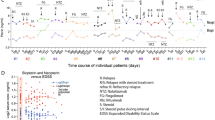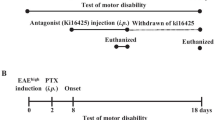Abstract
Several studies support a protective effect of vitamin D on multiple sclerosis and experimental allergic encephalomyelitis (EAE), but the mechanisms of these favorable effects are unclear. Our study demonstrates that sphingosine 1-phosphate (S1P) is upregulated in the serum and spinal cords of EAE rats, but that vitamin D reverses the upregulation to alleviate inflammation. Vitamin D, however, cannot prevent the disease process, suggesting that other factors may be involved. To identify additional factors that might limit vitamin D efficacy, we assessed the effects of vitamin D on plasma gelsolin (pGSN), a regulator of S1P that is downregulated in the CSF of MS patients. Our results show that pGSN is downregulated in the serum of EAE rats, whereas its cellular form, cytoplasmic gelsolin (cGSN), is upregulated in the spinal cord of EAE rats. Importantly, vitamin D causes a downregulation of both pGSN and cGSN, which may counteract the positive effects of S1P decrease. Furthermore, 48 and 42 kDa caspase-3 cleavage products of cGSN are detected in EAE spinal cords, suggesting enhanced apoptotic activity, but these cleaved products undergo a similar decrease upon vitamin D treatment. To directly test the role of cGSN in the apoptotic process, we performed RNA interference in PC-12, a rat sympathetic nerve cell line. Results verify that cGSN suppresses apoptosis induced by TNF-α. Collectively, these results support a therapeutic effect of vitamin D that is derived from its ability to reduce S1P, but is limited by its simultaneous effect in reducing pGSN and cGSN. Based on these observations, we postulate that combined therapy with recombinant human pGSN and vitamin D may produce more beneficial effect in treating multiple sclerosis.






Similar content being viewed by others
Abbreviations
- Caspase-3:
-
Cysteinyl aspartate-specific protease-3
- cGSN:
-
Cytoplasmic gelsolin
- CSF:
-
Cerebrospinal fluid
- EAE:
-
Experimental allergic encephalomyelitis
- GSN:
-
Gelsolin
- MS:
-
Multiple sclerosis
- OND:
-
Neurological disorder other than MS
- pGSN:
-
Plasma gelsolin
- S1P:
-
Sphingosine 1-phosphate
References
Compston A, Coles A (2008) Multiple sclerosis. Lancet 372:1502–1517
Stadelmann C (2011) Multiple sclerosis as a neurodegenerative disease: pathology, mechanisms and therapeutic implications. Curr Opin Neurol 24:224–229
Allen IV, Mckeown SR (1979) A histological, histochemical and biochemical study of the macroscopically normal white matter in multiple sclerosis. J Neurosci 41:81–91
Holley JE, Gveric D, Newcombe J, Cuzner ML, Gutowski NJ (2003) Astrocyte characterization in the multiple sclerosis scar. Neuropathol Appl Neurobiol 29:434–444
Ambrosini E, Remoli ME, Giacomini E et al (2005) Astrocytes produce dendritic cell-attracting chemokines in vitro and in multiple sclerosis lesions. J Neuropathol Exp Neurol 64:706–715
Constantinescu CS, Tani M, Ransohoff RM et al (2005) Astrocytes as antigen-presenting cells: expression of IL-12/IL-23. J Neurochem 95:331–340
Peterson JW, Bö L, Mörk S, Chang A, Trapp BD (2001) Transected neurites, apoptotic neurons, and reduced inflammation in cortical multiple sclerosis lesions. Ann Neurol 50:389–400
Meyer R, Weissert R, Diem R et al (2001) Acute neuronal apoptosis in a rat model of multiple sclerosis. J Neurosci 21(16):6214–6220
Murata N, Sato K, Kon J et al (2000) Interaction of sphingosine 1-phosphate with plasma components, including lipoproteins, regulates the lipid receptor-mediated actions. Biochem J 352:809–815
Olivera A, Spiegel S (1993) Sphingosine-1-phosphate as second messenger in cell proliferation induced by PDGF and FCS mitogens. Nature 365:557–560
Kohono M, Momoi M, Oo ML et al (2006) Intracellular role for sphingosine kinase 1 in intestinal adenoma cell proliferation. Mol Cell Biol 26:7211–7223
Spiegel S, Milstien S (2003) Sphingosine-1-phosphate: an enigmatic signalling lipid. Nat Rev Mol Cell Biol 4(5):397–407
Takabe K, Paugh SW, Milstien S, Spiegel S (2008) “Inside-Out” Signaling of Sphingosine-1-Phosphate: therapeutic targets. Pharmacol Rev 60:181–195
Pebay A, Toutant M, Premont J et al (2001) Sphingosine-1-phosphate induces proliferation of astrocytes: regulation by intracellular signalling cascades. Eur J Neurosci 13:2067–2076
Sorensen SD, Nicole O, Peavy RD et al (2003) Common signaling pathways link activation of murine PAR-1, LPA, and S1P receptors to proliferation of astrocytes. Mol Pharmacol 64:1199–1209
Brinkmann V (2009) FTY720 (fingolimod) in multiple sclerosis: therapeutic effects in the immune and the central nervous system. Br J Pharmacol 158(5):1173–1182
Zhang QH, Li JC, Dong N et al (2013) Burn injury induces gelsolin expression and cleavage in the brain of mice. Neuroscience 228:60–72
Lee WM, Galbraith RM (1992) The extracellular actin-scavenger system and actin toxicity. N Engl J Med 326(20):1335–1341
Bucki R, Georges PC, Espinassous Q et al (2005) Inactivation of endotoxin by human plasma gelsolin. Biochemistry 44(28):9590–9597
Goetzl EJ, Lee H, Azuma T, Stossel TP, Turck CW, Karliner JS (2000) Gelsolin binding and cellular presentation of lysophosphatidic acid. J Biol Chem 275(19):14573–14578
Mintzer E, Sargsyan H, Bittman R (2006) Lysophosphatidic acid and lipopolysaccharide bind to the PIP2-binding domain of gelsolin. Biochim Biophys Acta 1758(1):85–89
Bucki R, Kulakowska A, Byfield FJ et al (2010) Plasma gelsolin modulates cellular response to sphingosine 1-phosphate. Am J Physiol Cell Physiol 299(6):C1516–C1523
Kulakowska A, Drozdowski W, Sadzynski A, Bucki R, Janmey PA (2008) Gelsolin concentration in cerebrospinal fluid from patients with multiple sclerosis and other neurological disorders. Eur J Neurol 15(6):584–588
Kothakota S, Azuma T, Reinhard C et al (1997) Caspase-3-generated fragment of gelsolin: effector of morphological change in apoptosis. Science 278:294–298
Ohtsu M, Sakai N, Fujita H et al (1997) Inhibition of apoptosis by the actin-regulatory protein gelsolin. EMBO J 16(15):4650–4656
Ascherio A, Munger KL, Simon KC (2010) Vitamin D and multiple sclerosis. Lancet Neurol 9(6):599–612
Munger KL, Zhang SM, O'Reilly E et al (2004) Vitamin D intake and incidence of multiple sclerosis. Neurology 62(1):60–65
Cantorna MT, Hayes CE, DeLuca HF (1996) 1,25-Dihydroxyvitamin D3 reversibly blocks the progression of relapsing encephalomyelitis, a model of multiple sclerosis. Proc Natl Acad Sci U S A 93(15):7861–7864
McDonald WI, Compston A, Edan G et al (2001) Recommended diagnostic criteria for multiple sclerosis: guidelines from the International Panel on the diagnosis of multiple sclerosis. Ann Neurol 50(1):121–127
Yang M, Qin Z, Zhu Y, Li Y, Qin Y, Jing Y, Liu S (2013) Vitamin D-binding protein in cerebrospinal fluid is associated with multiple sclerosis progression. Mol Neurobiol 47(3):946–956
Smith SM, Levy NS, Hayes CE (1987) Impaired immunity in vitamin A-deficient mice. J Nutr 117(5):857–865
Spach KM, Hayes CE (2005) Vitamin D3 confers protection from autoimmune encephalomyelitis only in female mice. J Immunol 175(6):4119–4126
Min JK, Yoo HS, Lee EY, Lee WJ, Lee YM (2002) Simultaneous quantitative analysis of sphingoid base 1-phosphates in biological samples by o-phthalaldehyde precolumn derivatization after dephosphorylation with alkaline phosphatase. Anal Biochem 303(2):167–175
Froissard P, Duval D (1994) Cytotoxic effects of glutamic acid on PC12 cells. Neurochem Int 24(5):485–493
Liu S, Bai S, Qin Z, Yang Y, Cui Y, Qin Y (2009) Quantitative proteomic analysis of the cerebrospinal fluid of patients with multiple sclerosis. J Cell Mol Med 13(8A):1586–1603
Kurtzke JF (1977) Geography in multiple sclerosis. J Neurol 215(1):1–26
Auer DP, Schumann EM, Kümpfel T, Gössl C, Trenkwalder C (2000) Seasonal fluctuations of gadolinium-enhancing magnetic resonance imaging lesions in multiple sclerosis. Ann Neurol 47(2):276–277
Garcion E, Sindji L, Nataf S, Brachet P, Darcy F, Montero-Menei CN (2003) Treatment of experimental autoimmune encephalomyelitis in rat by 1,25-dihydroxyvitamin D3 leads to early effects within the central nervous system. Acta Neuropathol 105(5):438–448
Lemire JM, Archer DC (1991) 1,25-dihydroxyvitamin D3 prevents the in vivo induction of murine experimental autoimmune encephalomyelitis. J Clin Invest 87(3):1103–1107
Nataf S, Garcion E, Darcy F, Chabannes D, Muller JY, Brachet P (1996) 1,25 Dihydroxyvitamin D3 exerts regional effects in the central nervous system during experimental allergic encephalomyelitis. J Neuropathol Exp Neurol 55(8):904–914
Bhalla AK, Amento EP, Krane SM (1986) Differential effects of 1,25-dihydroxyvitamin D3 on human lymphocytes and monocyte/macrophages: inhibition of interleukin-2 and augmentation of interleukin-1 production. Cell Immunol 98(2):311–322
Müller K, Diamant M, Bendtzen K (1991) Inhibition of production and function of interleukin-6 by 1,25-dihydroxyvitamin D3. Immunol Lett 28(2):115–120
Müller K, Odum N, Bendtzen K (1993) 1,25-dihydroxyvitamin D3 selectively reduces interleukin-2 levels and proliferation of human T cell lines in vitro. Immunol Lett 35(2):177–182
Reichel H, Koeffler HP, Tobler A, Norman AW (1987) 1 alpha,25-Dihydroxyvitamin D3 inhibits gamma-interferon synthesis by normal human peripheral blood lymphocytes. Proc Natl Acad Sci U S A 84(10):3385–3389
Bassi R, Anelli V, Giussani P, Tettamanti G, Viani P, Riboni L (2006) Sphingosine-1-phosphate is released by cerebellar astrocytes in response to bFGF and induces astrocyte proliferation through Gi-protein-coupled receptors. Glia 53(6):621–630
Kappos L, Radue E-M, O'Connor P et al (2010) A placebo-controlled trial of oral fingolimod in relapsing multiple sclerosis. N Engl J Med 362:387–401
O'Brien N, Jones ST, Williams DG et al (2009) Production and characterization of monoclonal anti-sphingosine-1-phosphate antibodies. J Lipid Res 50(11):2245–2257
Yin HL, Kwiatkowski DJ, Mole JE, Cole FS (1984) Structure and biosynthesis of cytoplasmic and secreted variants of gelsolin. J Biol Chem 259(8):5271–5276
Janmey PA, Lind SE (1987) Capacity of human serum to depolymerize actin filaments. Blood 70(2):524–530
Lind SE, Smith DB, Janmey PA, Stossel TP (1986) Role of plasma gelsolin and the vitamin D-binding protein in clearing actin from the circulation. J Clin Invest 78(3):736–742
Lee PS, Drager LR, Stossel TP, Moore FD, Rogers SO (2006) Relationship of plasma gelsolin levels to outcomes in critically ill surgical patients. Ann Surg 243(3):399–403
Lee PS, Sampath K, Karumanchi SA et al (2009) Plasma gelsolin and circulating actin correlate with hemodialysis mortality. J Am Soc Nephrol 20(5):1140–1148
Ji L, Chauhan A, Chauhan V (2008) Cytoplasmic gelsolin in pheochromocytoma-12 cells forms a complex with amyloid beta-protein. Neuroreport 19(4):463–466
Ji L, Chauhan A, Chauhan V (2010) Upregulation of cytoplasmic gelsolin, an amyloid-beta-binding protein, under oxidative stress conditions: involvement of protein kinase C. J Alzheimers Dis 19(3):829–838
Leifeld L, Fink K, Debska G et al (2006) Anti-apoptotic function of gelsolin in fas antibody-induced liver failure in vivo. Am J Pathol 168(3):778–785
Rothenbach PA, Dahl B, Schwartz JJ et al (2004) Recombinant plasma gelsolin infusion attenuates burn-induced pulmonary microvascular dysfunction. J Appl Physiol 96(1):25–31
Zhang QH, Chen Q, Kang JR et al (2011) Treatment with gelsolin reduces brain inflammation and apoptotic signaling in mice following thermal injury. J Neuroinflammation 8:118
Acknowledgments
This work was supported by National Natural Science Foundation of China Grant 81070952 and 81271319.
Author information
Authors and Affiliations
Corresponding author
Additional information
Yanyan Zhu and Zhaoyu Qin contributed equally to this work.
Electronic Supplementary Material
Below is the link to the electronic supplementary material.
Supplementary Fig. 1
Establishment of the EAE rat model. A, The weight of EAE rats decreases between days 9 and 14 after MBP injection and gradually increases after day15. However, the weight of control rats gradually and consistently increases. B, Disease symptoms were monitored over 25 days of EAE induction. The symptom emerged at approximately day10, peaked on the day 13, and disappeared at day19. C, Pathological section of inflammatory lesions stained with hematoxylin and eosin. No obvious inflammation was observed in the cerebrum of control (C-I) or acute stage EAE (C-II) rats; or in the spinal cord of control (C-III) or pre-stage (C-IV) rats. However, the spinal cord of EAE rats in the acute stage (C-V) developed serious lesions. (×400 magnification, scale bar 10 μm) (GIF 26 kb)
ESM 2
(DOCX 233 kb)
ESM 3
(DOCX 498 kb)
ESM 4
(DOCX 14 kb)
ESM 5
(DOCX 18 kb)
ESM 6
(DOCX 12 kb)
ESM 7
(DOCX 12 kb)
Rights and permissions
About this article
Cite this article
Zhu, Y., Qin, Z., Gao, J. et al. Vitamin D Therapy in Experimental Allergic Encephalomyelitis Could be Limited by Opposing Effects of Sphingosine 1-Phosphate and Gelsolin Dysregulation. Mol Neurobiol 50, 733–743 (2014). https://doi.org/10.1007/s12035-014-8686-9
Received:
Accepted:
Published:
Issue Date:
DOI: https://doi.org/10.1007/s12035-014-8686-9




